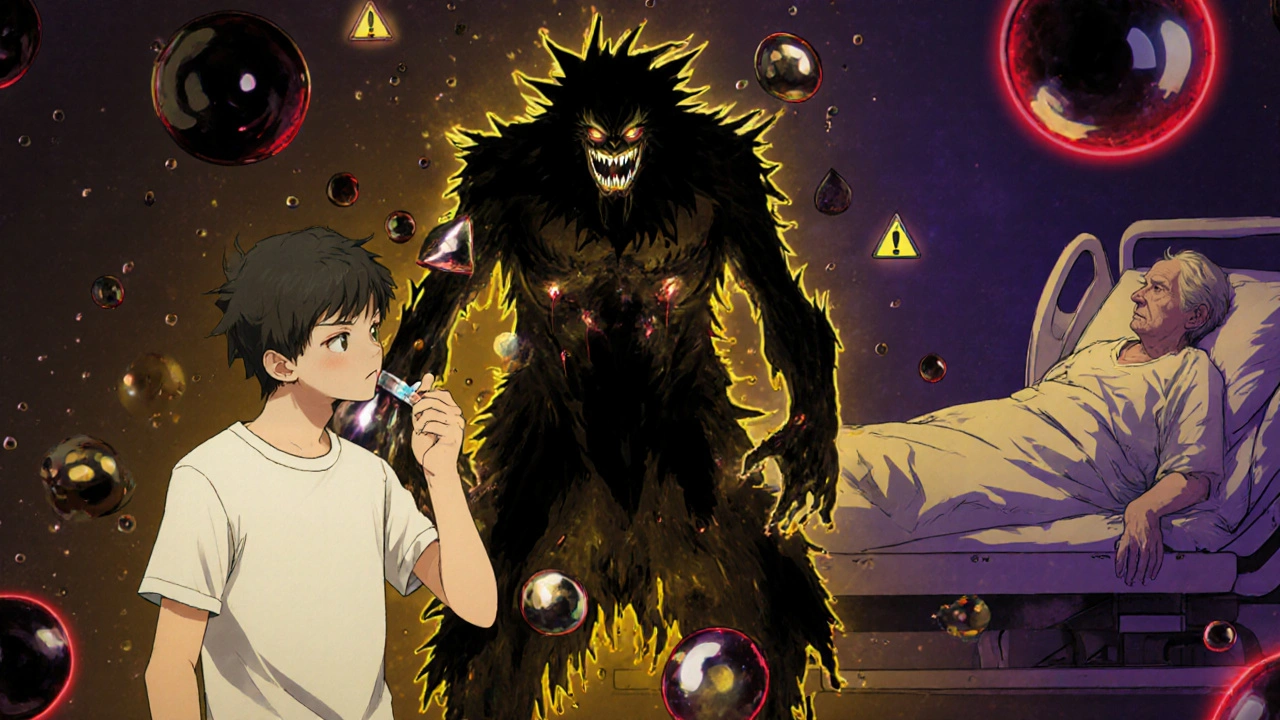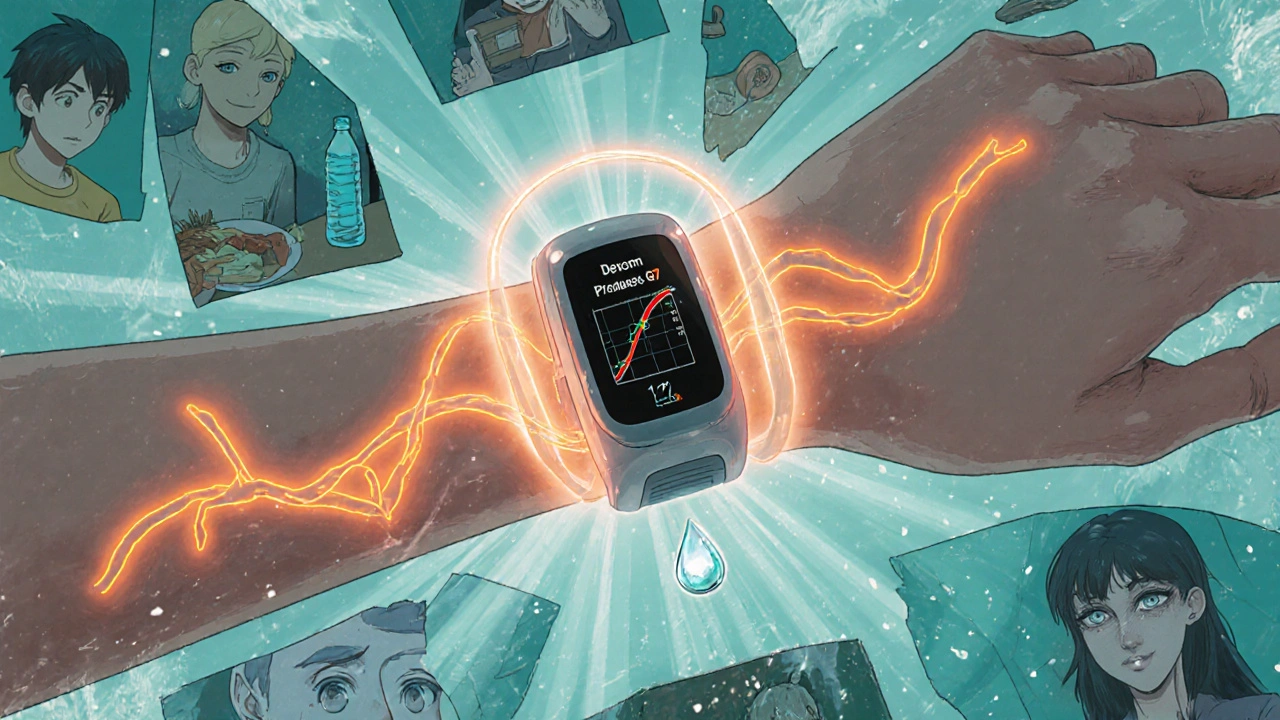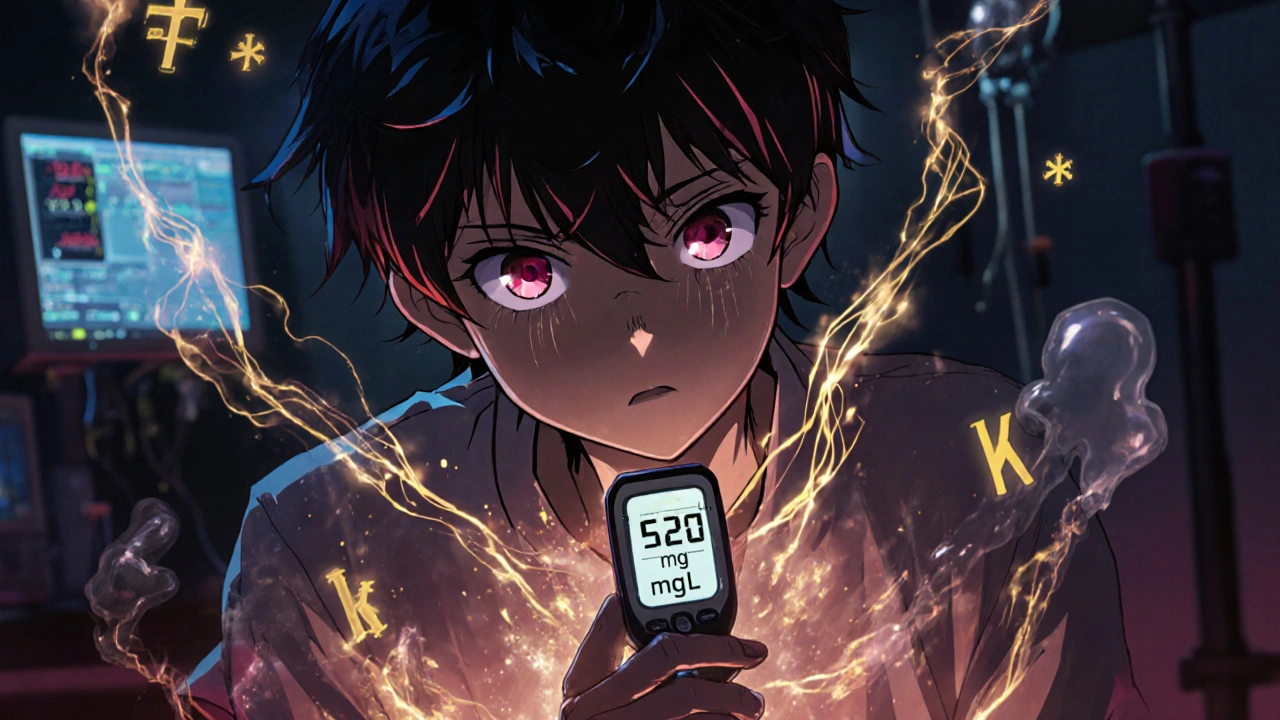When your blood sugar climbs too high, it doesn’t just feel like being tired or thirsty-it can turn life-threatening in hours. Hyperglycemia isn’t just a number on a glucometer. It’s your body screaming for help. For people with diabetes, ignoring early signs can lead to diabetic ketoacidosis (DKA) or hyperosmolar hyperglycemic state (HHS)-two emergencies that send tens of thousands to hospitals every year in the U.S. alone. And it’s not just about insulin. It’s about recognizing the subtle clues before your body shuts down.
What Happens When Blood Sugar Goes Too High?
Hyperglycemia means your blood glucose is above 180 mg/dL. That’s the point where your kidneys start spilling sugar into your urine. But what’s really happening inside your body? Your cells are starving-even though there’s plenty of glucose floating around. Without enough insulin (or if your body can’t use it properly), glucose can’t get into your muscles, fat, or brain. So it piles up in your blood. That’s hyperglycemia.
It’s not just type 1 diabetes. Type 2 patients experience it too, especially when they’re sick, stressed, or skip doses. Even people without diabetes can get it after major surgery, severe infections, or while taking steroids. The root cause? Insulin doesn’t do its job. And when that happens, your body starts breaking down fat for energy-producing toxic ketones.
Early Signs You Can’t Afford to Ignore
Most people wait until they’re dizzy or confused before acting. But the earliest signs are quiet. They sneak in when you’re busy, tired, or just thinking, “I’ll check later.”
- Urinating more than usual-sometimes every hour, especially at night. You might go through a whole bottle of water in a few hours.
- Thirst that won’t quit. Drinking 4 liters or more a day and still feeling dry.
- Blurry vision. Not from screen fatigue. From sugar pulling fluid out of your eye lenses.
- Fatigue that doesn’t go away with sleep. Not just “I had a long day.” This is bone-deep exhaustion.
These aren’t just inconveniences. They’re your body’s first warning system. A 2023 survey found that 67% of people didn’t realize their symptoms were high blood sugar until their levels hit over 300 mg/dL. By then, it’s already slipping into danger.
When It Gets Serious: The Red Flags
Once your blood sugar climbs past 250 mg/dL, things change fast. The body starts to break down fat for fuel. That’s when ketones show up.
- Headaches that feel like pressure behind the eyes.
- Difficulty focusing-like your thoughts are underwater.
- Unexplained weight loss. Not from dieting. Losing 5% or more of your body weight in a few weeks without trying.
- Nausea or stomach pain. Often mistaken for the flu.
At 300 mg/dL and above, neurological symptoms kick in. You might feel sluggish, confused, or disoriented. Your speech might slur. Your hands might shake. These aren’t normal stress reactions. They’re signs your brain is being starved of proper fuel.
And then there’s the emergency zone: above 600 mg/dL. That’s when hyperosmolar hyperglycemic state (HHS) can occur. Your blood becomes thick like syrup. Your organs start failing. Dehydration hits hard-up to 12 liters of fluid lost. Mortality rates jump to 15-20% in older adults. This isn’t hypothetical. It happens every day.
DKA vs. HHS: Knowing the Difference Could Save Your Life
Not all high blood sugar emergencies are the same. Two major conditions can develop: diabetic ketoacidosis (DKA) and hyperosmolar hyperglycemic state (HHS). They look similar but behave very differently.
| Feature | Diabetic Ketoacidosis (DKA) | Hyperosmolar Hyperglycemic State (HHS) |
|---|---|---|
| Typical patient | Usually type 1 diabetes | Usually type 2 diabetes, often older adults |
| Onset | Fast-24 to 48 hours | Slow-days to weeks |
| Blood glucose | Usually >250 mg/dL | Usually >600 mg/dL |
| Ketones | High | Low or absent |
| Dehydration | Moderate | Severe-fluid loss of 8-12 liters |
| Neurological symptoms | Mild confusion or drowsiness | Severe lethargy, seizures, coma |
| Breath odor | Fruity or acetone-like | Usually no distinct odor |
| Mortality rate | 1-5% | 15-20% |
DKA often hits younger people suddenly after an infection or missed insulin. HHS creeps up on older adults, especially those with undiagnosed diabetes or who don’t drink enough water. Both need emergency care. But HHS kills more often-and faster.

What to Do When Blood Sugar Hits 240 mg/dL or Higher
If your reading is above 240 mg/dL, don’t wait. Don’t hope it’ll go down on its own. Don’t assume it’s just “a bad day.”
- Check for ketones. Use a urine test strip or a blood ketone meter. If ketones are moderate or high, you’re at risk for DKA.
- Take your fast-acting insulin. Use your correction dose. Most people need 0.1 units per kilogram of body weight every hour until levels drop. Never skip this step.
- Drink water. 8-16 ounces every hour. Sugar-free fluids only. No soda, juice, or energy drinks. You’re trying to flush out sugar and ketones.
- Don’t exercise. Moving around when ketones are present can make things worse by pushing more glucose into your blood.
- Call your doctor or go to the ER if: Blood sugar stays above 300 mg/dL for more than two checks, ketones are high, you’re vomiting, confused, or having trouble breathing.
Insulin stacking-giving too much insulin too fast-is a common mistake. It can crash your blood sugar into dangerous hypoglycemia. Always follow your personalized correction plan. If you’re unsure, call your endocrinologist or the ADA hotline.
Why People Delay Acting (And Why That’s Deadly)
Most emergency cases don’t start with panic. They start with denial.
“I’m just tired.”
“I drank too much coffee last night.”
“It’s just a cold.”
Reddit users shared over 120 stories in early 2024 where people waited too long. One man waited three days after his blood sugar hit 520 mg/dL because he thought he was “just dehydrated.” He ended up in ICU with HHS. Another woman skipped insulin for two days because she didn’t want to “bother” her family.
Stress, shame, and diabetes burnout are real. But every hour you wait increases your risk of brain swelling, kidney failure, or cardiac arrest.
What’s New in Prevention and Monitoring
Technology is changing the game. In January 2024, the FDA approved Dexcom G7’s “Glucose Guardian”-an algorithm that predicts high blood sugar 30 minutes before it happens. Users saw a 31% drop in severe hyperglycemia episodes.
Continuous glucose monitors (CGMs) are no longer luxury tools. They’re lifesavers. People using them respond to spikes 74 minutes faster than those relying on fingersticks. That’s the difference between a quick correction and a hospital trip.
The NIH is now funding a $150 million initiative to use AI and wearable sensors to catch hyperglycemia before it starts. And by 2025, new guidelines will relax blood sugar targets for seniors-because chasing “perfect” numbers can be more dangerous than slightly elevated levels in older adults.

Who’s at Highest Risk?
It’s not just about having diabetes. Certain groups face much higher danger:
- People over 65: HHS mortality is 22% in this group.
- Children with type 1 diabetes: DKA is the leading cause of diabetes-related death in kids.
- Black and Hispanic communities: CDC data shows they experience 2.3 times more hyperglycemia emergencies-often due to lack of insulin access or delayed care.
- Those on steroids or with infections: Even people without diabetes can crash into hyperglycemia after taking prednisone or fighting pneumonia.
If you fall into any of these groups, talk to your doctor about a personalized emergency plan. Keep ketone strips handy. Teach your family what to look for. Don’t wait for a crisis to learn.
How to Avoid Recurring Episodes
One high blood sugar event is scary. Two or three? That’s a pattern. And patterns can be broken.
Common triggers:
- Illness (42% of cases)
- Carb-counting mistakes (29%)
- Insulin pump failures (18%)
- Emotional stress (11%)
Fix the root causes:
- Keep a log of when highs happen. Look for patterns-morning spikes? After meals? During stress?
- Check your insulin pump regularly. Replace tubing and reservoirs every 2-3 days.
- Use apps that track carbs and insulin ratios. Many now auto-calculate corrections.
- Manage stress with breathing exercises, walking, or talking to a counselor. Stress hormones like cortisol spike blood sugar.
- Get tested for gastroparesis if you’re having unexplained highs. Delayed stomach emptying can make insulin timing useless.
Structured education programs like the CDC’s Diabetes Self-Management Education reduce emergency visits by 42%. You’re not alone. Help exists.
Final Thought: This Isn’t Just About Numbers
Hyperglycemia isn’t a failure. It’s a signal. A biological alarm. It’s not about being perfect. It’s about being aware. About checking your levels when you feel off. About drinking water even when you’re not thirsty. About calling for help before you’re too weak to speak.
Every day, people survive these emergencies because someone noticed a symptom early. Because they acted. Because they didn’t wait.
Your body is trying to tell you something. Listen before it’s too late.
What blood sugar level is considered dangerous?
A blood glucose level above 240 mg/dL is a warning sign that you need to take action. Levels above 300 mg/dL are considered severe and increase your risk of diabetic ketoacidosis (DKA) or hyperosmolar hyperglycemic state (HHS). Above 600 mg/dL is a medical emergency requiring immediate hospital care. Always check for ketones if your blood sugar is above 240 mg/dL.
Can you have high blood sugar without having diabetes?
Yes. Severe infections, major surgery, trauma, or medications like steroids (prednisone) can cause temporary hyperglycemia in people without diabetes. Conditions like Cushing’s syndrome or chronic pancreatitis can also lead to persistent high blood sugar. If you experience repeated high readings without a diabetes diagnosis, see a doctor for testing.
How do I know if I’m in diabetic ketoacidosis (DKA)?
Signs of DKA include high blood sugar (over 250 mg/dL), high ketones in urine or blood, nausea or vomiting, abdominal pain, rapid breathing with a fruity or acetone-like odor, and confusion. If you have these symptoms, take insulin, drink water, and seek emergency care immediately. Do not delay-DKA can turn fatal within hours.
Should I exercise if my blood sugar is high?
No-not if your blood sugar is above 250 mg/dL and ketones are present. Exercise can cause your liver to release even more glucose, making the situation worse. Wait until your blood sugar is under control and ketones are negative before resuming physical activity. Light walking may help if your levels are mildly elevated and ketones are absent.
What’s the best way to prevent hyperglycemia?
Regular blood sugar monitoring, consistent insulin or medication use, accurate carb counting, staying hydrated, managing stress, and checking for illness or infection are key. Using a continuous glucose monitor (CGM) with alerts can reduce high blood sugar episodes by over 50%. Attend diabetes education programs-they cut emergency visits by nearly half.
Is it safe to wait and see if high blood sugar goes down on its own?
No. Waiting can lead to life-threatening complications like DKA or HHS. Even if you feel fine, high blood sugar is damaging your blood vessels, nerves, and organs. If your reading is above 240 mg/dL, test for ketones and take your correction dose. If levels don’t drop after 2-3 hours or you feel unwell, call your doctor or go to the ER.

Andrew Baggley
November 19, 2025 AT 13:24